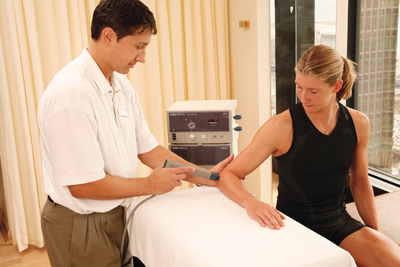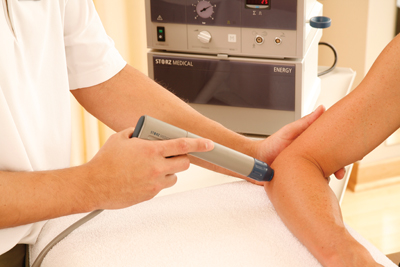
It has been four years since the introduction of radial shockwave
therapy (SWT) by Storz into the Canadian market and to CMCC, otherwise
known as extracorporeal pulse activated treatment (EPAT) in the United
States.
It has been four years since the introduction of radial shockwave therapy (SWT) by Storz into the Canadian market and to CMCC, otherwise known as extracorporeal pulse activated treatment (EPAT) in the United States. The technology has progressed and so have the techniques. Hundreds of chiropractors across the country have used shockwave to treat a myriad of conditions and have developed new techniques along the way. Innovations by such chiropractors as Dr. Lawrence Micheli in Toronto and Dr. Jamie Gimes in Victoria have advanced the rehabilitation and healing of their patients far beyond their expectations.
 |
| Dr. Lawrence Micheli treats one of many injuries for professional ironman Tara Norton. Advertisement
|
Routine indications for rehabilitative treatment, such as tendinopathies and plantar fasciitis, have become more successful in their resolution with shockwave therapy. Combining SWT treatments with traditional chiropractic care has elevated the healing process to new heights.
“Shockwave therapy was introduced to me as a treatment modality about four years ago,” says Dr. Micheli. “Initially, I was very skeptical of the potential outcomes that were being reported. The literature was showing very positive results for plantar fasciitis, as well as mixed to positive outcomes for achilles and patellar tendinopathy, tennis elbow (lateral epicondylitis) and calcific tendonitis.”
”So when we first starting using our shockwave therapy modality, we used it on feet, Achilles tendons, knees, elbows and shoulders. The results were very good and our confidence of using SWT increased with time.”
The contributions of chiropractors
Last year the American Journal of Sports Medicine published three double blind randomized articles on the success of treating plantar fasciitis, patellar tendinopathy and achilles tendonpathy. Chiropractors have now developed and evolved SWT to treat conditions such as piriformis syndrome, frozen shoulder, hallux rigidus, quad hamstring and adductor strains. The most striking and beneficial effects have been on trigger points. The immediate relief provided by SWT has been a momentous step forward in relieving patients symptomatology.
Working in synergy with chiropractors has also facilitated the treatment of stress fractures, post-operative healing of tendon bone-interfaces and calcific tendinopathies with far greater success than traditional methods such as ultrasound, interferential, laser and manual techniques. Traditionally, for numerous students and practising chiropractors, there has been very poor evidence for the successful treatment of tendinopathies with the traditional treatments available – SWT has improved this situation.
 |
|
| The repetitive trauma of training and competing makes shockwave therapy (SWT) a valuable tool for healing certain injuries.
|
“In 2007, I attended a shockwave symposium where Dr. Gleitz from Luxenbourg presented on the strategies and benefits of using SWT for the treatment of trigger points and various myofascial conditions,” continues Dr. Micheli. “After that, we started to use SWT on more conditions than just insertional tendinopathies. The healing of injuries and treatment outcomes significantly improved, more so than with any other modality we have used in the past.”
“We observed an excellent example of this improved healing potential last year following the world ironman championships. One of my athletes, preparing for competition, suffered a horrific bike crash, which would have ended her career. Fortunately, through a combination of Active Release Techniques (ART) and SWT, we had her back training and competing again within no time.”
Costs to the chiropractor and patient accessibility
Shockwave therapy has been made affordable and accessible to all Canadians by Storz, Shockwave Canada, third party insurance and Workers Compensation. This has helped to make SWT an integral part of the rehabilitation process. In fact, one jurisdiction in western Canada relocates patients to clinics where SWT is available.
“SWT was an easy transition into my practice as I already used Active Release Techniques (ART) for manually diagnosing and treating soft tissue related dysfunction,” notes Micheli. “The application of shockwave only takes five to seven minutes and it can be used on almost any injury.”
“This modality has now become an integral part of our clinic,” concludes Dr. Micheli. “On average we probably use SWT 15 to 20 times per day, which more than recovers the cost of the unit for the chiropractor in less than one year. One interesting result that we have noticed is that patients have also realized how impactful the modality has been on their recovery. In fact, they have realized this to the point where they actually request SWT to be a part of the treatment plan after they have sustained an injury.”
Dr. Jamie Grimes is a chiropractor and clinic director for Synergy Health Management in Victoria, British Columbia. He notes, “In my thirteen years in practice, I’ve worked with multiple Olympic gold medallists, record holders and professional athletes in many sports. In order to be able to get them recovered quickly, and back to training fast, I’ve had to stay ahead of the curve and learn many techniques from physicians and therapists from many countries all over the world. However, until I discovered extracorporeal pulse activated treatment in Europe, I had never come across a treatment that could reliably and completely resolve chronic nagging tendon or ligament to bone enthesopathies, nor one that healed acute enthesopathies in record time. We now use it for removing stubborn trigger points and needle free acupuncture with incredible success. In our community we have become the established expert leaders in shockwave therapy and rehabilitation. We receive regular referrals from the local GPs, sports medicine specialists, physiatrists and orthopedic surgeons in order to treat their patients and avoid surgery. Pulse activated treatment is proven in the literature and it works.”
An impressive technological advance, SWT has benefited patients worldwide and new SWT techniques and treatments are constantly emerging, globally. SWT is now ubiquitous and appreciated by patients around the world. The uses for SWT are limited only by one’s imagination and skill.
Print this page